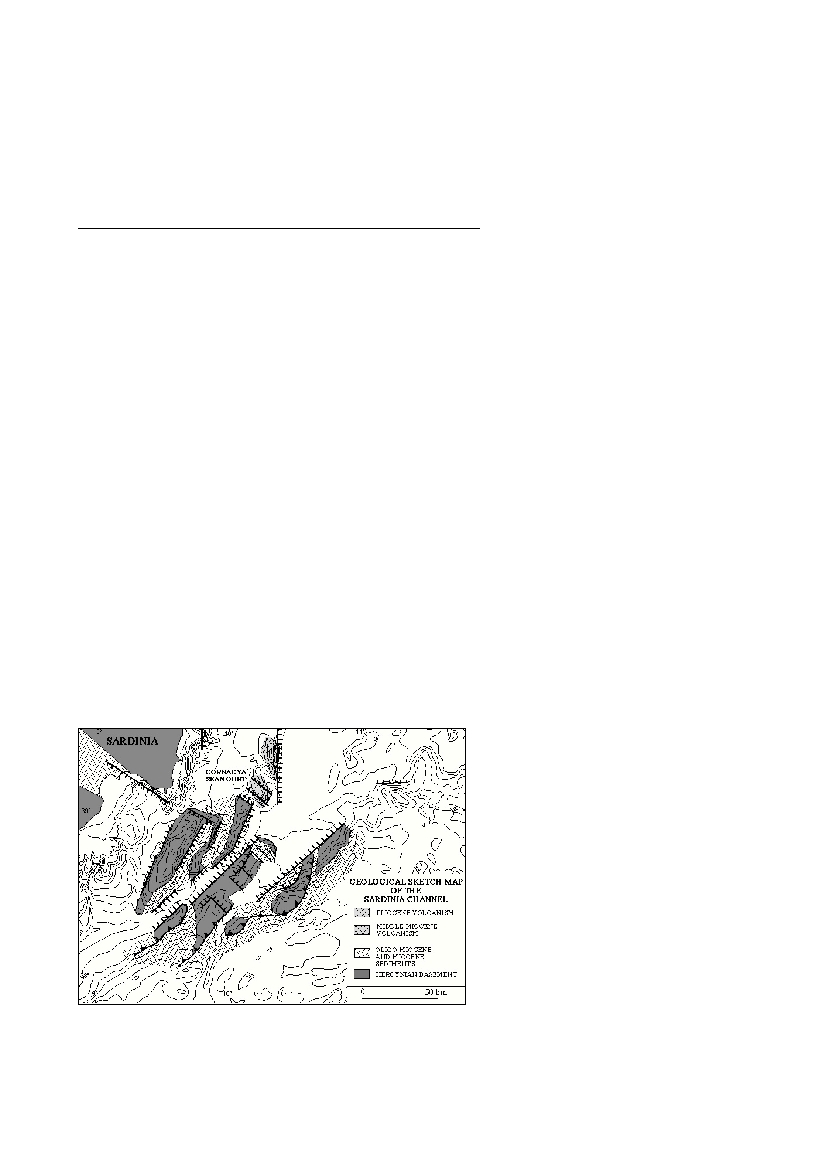Rapp. Comm. int. Mer Médit., 36,2001
12
S
ARCYA
andS
ARTUCYA
dives
Early stages of the European margin outer blocks break-off that led
to separation of Calabria and Peloritan terranes from Sardinia
achieved elsewhere in the Tyrrhenian Sea. Slope steepness and deep
sea water currents prevented burial of the channel margins under
pelagic sediments thus allowing visual investigations. Dives data
include 112 rock samples and a 78 hours film record.
Basement and sedimentary cover oligo-miocene evolution
Sardinian channel basement is made of metamorphic panafrican to
hercynian rocks weakly metamorphised during alpine orogenesis.
Like the on-shore Calabrian-Peloritan-Kabylian (CPK) basement, it
records a oligo-miocene crustal thickening and erosion, here increas-
ing toward the CPK front (as suggested by
40
Ar /3
9
Ar and apatite fis-
sion track datings).
The channel basement is overlain by the oligo-miocene detrital
cover of peloritan or kabylian type. The dives led to the discovery of
shoshonitic tortonian volcanism on both the sardinian and tunisian
margins.
The South Cornaglia Scarp is characterized by lower slopes devel-
oped on the basement. They display a succession of scree-covered tri-
angular facets and deep narrow canyons fringed with high cliffs.
Above the lower slopes, the tertiary sedimentary cover is buried under
more than 100m plio-pleistocene pelagic sediments deposited on a
subdued relief in large valleys. Thus the tertiary sediments only out-
crop in the canyon heads. A wide span of CPK sedimentary formations
were sampled, however, as loose blocks on the lower slopes. The mor-
phologic signature of the tertiary cover was used to draw a geological
scheme of the channel (see figure). The south scarp exhibits several
aprons, oblique to the main scarp direction. They could result from
differential erosion around basement rocks or mezosoic limestones. As
theTeulada Apron stands above a shallow dipping crustal re?ector,
they could be basement units thrusted over the sedimentary cover, or
alternatively they could result from the intersection of the Late
Miocene channel fault scarps with older rifted structures. Tertiary sed-
iments were also found as pebbles along the sardinian slopes. They
could lie on top of the tilted blocks along the Sardinian Margin and on
the Median Ridge.
Indices of an early inversion
In some places, differential erosion has stripped off the basement
topography drawned under the first oligo-miocene sediments. The
interface is quite ?at, broken by numerous fault scarps like in the
Peloritan Mountains. This surface could account for the ?at topped
Teulada Apron and Median Ridge.
This buried faulted topography documents a regionally known early
stage of extension during the ligurian-algerian rifting. This first tec-
tonic inversion directly follows the stage of crustal thickening.
Tortonian evolution: the second period of faulting
Incipient tyrrhenian rifting propagated into the channel area during
tortonian times and created the present trough. Whereas opening of
neighbouringTyrrhenian Sea is still an active process, it stopped
abruptly before Messinian in the channel, and did not reached
oceanization. Fractures orientations show that almost all the older
structures were reactivated and that tyrrhenian strike-slip and normal
faults directions prevail.
The Sardinian Margin exhibits a classical structure with 3 main
steps of tilted crustal blocks and faulted relief at all scales. The
Sicilian-Tunisian Margin formation could involve larger strike-slip
components. It has been argued that the present slopes are detachment
surfaces inverting older oligo-miocene thrusts. They would connect in
the crust to shallow-dipping re?ectors detected on deep seismic
records. The slopes investigated here did not show evidence of the
strong deformations that could be expected on pristine denudation
slopes. However, those are not representative of the south margin as a
whole.
Messinian evolution
The channel bottom is filled with several hundred meters of
messinian evaporites. They grade into detrital formations at the foot of
surrounding canyons. This suggest a continental evolution of the
scarps consistent with a sea level drop.
Some conglomerates were found scattered on the Median Ridge and
the Sicilian Margin slopes . They stand for possible remnants of con-
tinental or ?uvial erosion. However, the other features observed on
dive sites can be explained by post-miocene submarine gravitational
processes: rock slide, rock fall, rock avalanches.
Quaternary evolution
Scree deposits several tens of meter thick blanket the lower
slopes of the South Cornaglia Scarp. They are filled with a
quaternary pelagic micrite and breached in some places by
recent faults bringing the basement to the surface. Those dis-
locations are located on topographic ?exures well visible on
bathymetric maps. The ?exures are linked to recent reverse
activity on former normal faults, as it can be noticed at the
foot of the Cornaglia Scarp where a ridge is growing into the
sediments and dams the canyon outlets. This strain regime is
also responsible for a wide bulge drawning canyons of the
Sentinelle Apron. Other fold-like structures postdating ero-
sion features surround the Median Ridge and the Sentinelle
Apron. The in?uence of gravity driven instabilities cannot be
excluded in their growth.
MORPHOLOGY, STRUCTURE AND EVOLUTION OF THE SARDINIAN CHANNEL
G. Brocard*, J.P. Bouillin, P.Tricart, G. Mascle and the SARCYA-SARTUCYA Scientific Party.
Laboratoire de Géodynamique des Chaines Alpines. UMR-CNRS 5025/UJF-Grenoble, France - gbrocard@ujf-grenoble.fr
Abstract
The Sardinian Channel is located in a 400 km-long submerged section of the maghrebian branch of the Alpine chain. This 2000m deep
trough connects the Algerian-Ligurian and Tyrrhenian Oceanic Basins. Sixteen dives were conducted on the channel scarps using CYANA
submersible during two cruises in 1994 and 1995. A structural and morphological study involving film, seismic profile, relief map and
sample analyses allowed recognition of the basement and its sedimentary cover.The oligo-miocene crustal thickening is followed by an
early oligo-miocene extension and a latter tortonian rifting. A quaternary compressive event eventually inverts inherited extensive struc-
tures.
Keywords : Geomorphology, Basin formation, Tyrrhenian basin, Algerian Basin

